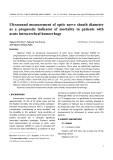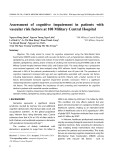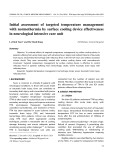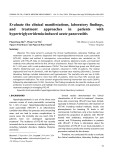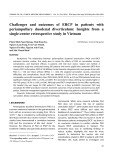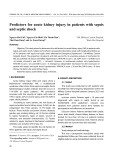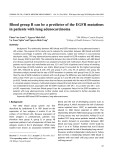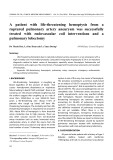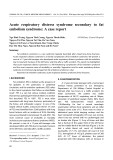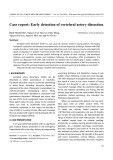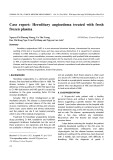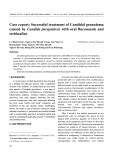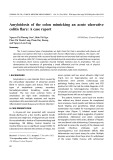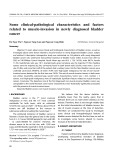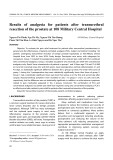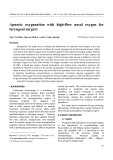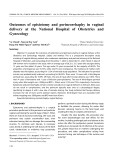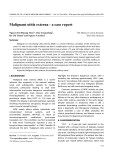
HUE JOURNAL OF MEDICINE AND PHARMACY ISSN 3030-4318; eISSN: 3030-4326HUE JOURNAL OF MEDICINE AND PHARMACY ISSN 3030-4318; eISSN: 3030-4326
72 73
Hue Journal of Medicine and Pharmacy, Volume 15, No.2/2025 Hue Journal of Medicine and Pharmacy, Volume 15, No.2/2025
The presence of bacteria on periodontal ligament cells in different
storage environments for teeth after displacement from the alveolar
bone: preliminary in vitro research results
Phan Anh Chi1*, Le Thi Thu Nga1, Tran Thi Thanh Ngan1, Le Thi Bao Chi2
(1) Faculty of Odonto-Stomatology, University of Medecine and Pharmacy, Hue University
(2) Department of Microbiology, University of Medicine and Pharmacy, Hue University
Abstract
Introduction: Teeth displaced from their alveolar bone can be replanted if properly handled and stored in
suitable environments. To help minimize the failure of reimplantation, teeth should be preserved in a storage
environment that is initially free of bacteria. Research objective: Evaluating the morphology of bacteria
on the periodontal ligament cells in different storage environments at various time points after the teeth
have been removed from the alveolar bone using Gram staining. Materials and Methods: An in vitro study
without a control group was conducted using 48 premolars and third molars after extraction, which were
stored in four environments: Dulbecco’s modified Eagle’s medium (DMEM), fresh whole milk (unsweetened),
saline solution, and electrolyte-replenishing drink. The presence of bacteria was assessed at four time
points: 30 minutes, 1 hour, 2 hours, and 24 hours. Results: In DMEM and fresh whole milk, Gram-positive
cocci, Gram-positive bacilli, and Gram-negative bacilli were presented at 30 minutes, 1 hour, and 2 hours;
by 24 hours, Gram-negative cocci were also presented. In the saline solution, Gram-positive cocci and bacilli
were also presented at all time points; Gram-negative bacilli appeared at 2 and 24 hours. In the electrolyte-
replenishing drink, Gram-positive cocci were the only bacteria found at all time points. Conclusion: Bacteria
were presented on the periodontal ligament cells of the root surface in all four environments and at all four-
time points of storage. However, at different time points, the number of bacterial groups found in DMEM and
fresh whole milk was the highest and nearly equivalent, followed by the saline solution and the lowest count
in the electrolyte-replenishing drink.
Keywords: bacteria, periodontal ligament cells, alveolar bone.
*Corresponding Author: Phan Anh Chi. Email: pachi@huemed-univ.edu.vn
Received: 15/10/2024; Accepted: 20/3/2025; Published: 28/4/2025
DOI: 10.34071/jmp.2025.2.11
1. INTRODUCTION
Teeth that are displaced from the alveolar bone
account for approximately 0.5 - 16% of all dental
trauma cases [1]. This severe dental injury causes
damage to the periodontal ligament, severs the
neurovascular bundle at the root apex, and may lead
to pulp necrosis. Immediate reimplantation of the
tooth into the alveolar bone is considered ideal and
is recommended only for permanent teeth; however,
it may not always be feasible [2]. Teeth can be
replanted into the alveolar bone if properly handled
and stored in a suitable environment. This helps
prevent drying, reducing surface root resorption and
increasing the chances of survival for periodontal
ligament cells [3]. Two of the most critical factors
affecting the prognosis of a tooth displaced from the
alveolar bone after reimplantation are the duration
of external drying and the storage environment
of the tooth [4]. Preserving the tooth in a suitable
storage environment that can maintain the viability
of the remaining periodontal ligament cells on the
root surface for as long as possible is key to the
successful reimplantation of the tooth into the
alveolar bone [5].
Recent studies have diversified the options
for the best storage environment; however, no
single storage environment has all the necessary
characteristics for tooth preservation. The ideal
medium must be capable of maintaining the
viability of periodontal ligament and pulp cells, have
physiological osmolarity and pH, possess antioxidant
properties, contain minimal or no bacterial
contamination, and be readily available in locations
where accidents occur, such as playgrounds, sports
fields, homes, schools, and hospitals, all while being
cost-effective [6].
The storage environments mentioned include
Hank’s Balanced Salt Solution (HBSS), Minimum
Essential Medium (MEM), Dulbecco’s Modified
Eagle’s Medium (DMEM), milk, coconut water, saline
solution, Save-A-Tooth, propolis, egg white, green
tea, aloe vera, saliva, soy milk, probiotics, royal jelly,
rice water, electrolyte-replenishing drinks, oresol
solution, and Emdogain [7-11]. Several national





